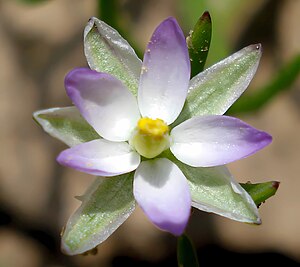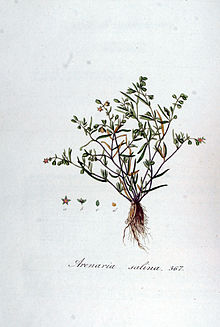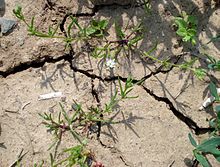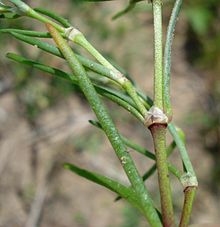Salt chickweed
| Salt chickweed | ||||||||||||
|---|---|---|---|---|---|---|---|---|---|---|---|---|

Salt chickweed ( Spergularia marina ) |
||||||||||||
| Systematics | ||||||||||||
|
||||||||||||
| Scientific name | ||||||||||||
| Spergularia marina | ||||||||||||
| ( L. ) Griseb. |
The salt chickweed ( Spergularia marina (L.) Griseb., Syn .: Spergularia salina C. Presl & J. Presl ) is a species of the genus Schuppenmiere ( Spergularia ) within the carnation family (Caryophyllaceae).
description
Vegetative characteristics
The salt chickweed is an annual overwintering or summer annual herbaceous plant that only reaches heights of 5 to 15 centimeters. The prostrate to ascending stem is richly branched. The stumpy thick-fleshed leaves are up to 2 centimeters long and oblong-linear. The little shiny stipules are ovate and slightly membranous.
Generative characteristics
The flowering period extends from May to September. The hermaphrodite flowers are five-fold with a double flower envelope . The five sepals are only about 3 millimeters long and have a skin border. The petals, which are deep pink from the outside to the center and white at the base, are shorter than the sepals. Each flower usually forms five stamens , only rarely can the number fluctuate between two and nine. There are three styluses.
The capsule fruit is ripe about 5 millimeters long and has three flaps. In contrast to the winged chickweed , most seeds do not have a wide wing edge.
The number of chromosomes is 2n = 36.
Occurrence and endangerment
The salt chickweed occurs in both the northern and southern hemispheres . It is a meridional to boreal floral element . Their natural range is on all coasts of the temperate to subarctic areas of the world. It appears as a neophyte in the tropical montane regions of the New World . However, their populations are currently declining worldwide as their habitat is increasingly being destroyed by humans. Salt chickweed is on the red list in parts of Germany (federal states of North Rhine-Westphalia and Rhineland-Palatinate). In Baden-Württemberg it was thought to be lost, but has been found on salt dumps and at roadsides in recent years. They are very rarely found in Northern Bavaria. In Brandenburg it is threatened with extinction - the largest salt and chickweed lawn (Spergulario-Puccinelietum distantis) in Brandenburg is formed by the Luchwiesen .
The salt chickweed has its main occurrence on salt marshes and salt plant corridors with changing moisture. But it can also be found on the banks of salty rivers, on salt dumps and on the edges of roads that are heavily salted in winter. The salt chickweed is the characteristic species of the plant association Puccinellietum distantis on the coast and has its main occurrence in the inland in the association Chenopodietum rubri of the association Chenopodion rubri. It often occurs together with the samphire , swaths of salt and some representatives of the goosefoot family .
Taxonomy
Carl von Linné described the basionyma Arenaria rubra var. Marina L. The variety was raised to a species in 1812 by Adrian Hardy Haworth as Stipularia marina (L.) Haw. August Grisebach then presented it as Spergularia marina (L.) Griseb. in Spic. fl. rumel. 1: 213. 1843 to the today valid genus Spergularia . A synonym of the species is Spergularia salina J. Presl & C. Presl (1819).
literature
- Eckehart J. Jäger, Klaus Werner (Ed.): Excursion flora from Germany . Founded by Werner Rothmaler. 10th edited edition. tape 4 : Vascular Plants: Critical Volume . Elsevier, Spektrum Akademischer Verlag, Munich / Heidelberg 2005, ISBN 3-8274-1496-2 .
- Ruprecht Düll , Herfried Kutzelnigg : Pocket dictionary of plants in Germany. A botanical-ecological excursion companion to the most important species . 6th, completely revised edition. Quelle & Meyer, Wiebelsheim 2005, ISBN 3-494-01397-7 .
- Franz Fukarek , Heinz executioner : Flora of Mecklenburg-Western Pomerania. Fern and flowering plants . Weissdorn, Jena 2006, ISBN 3-936055-07-6 .
- Karol Marhold, 2011: Caryophyllaceae. : Spergularia marina (L.) Griseb. at Euro + Med Plantbase - the information resource for Euro-Mediterranean plant diversity.
- Spergularia marina in the Germplasm Resources Information Network (GRIN), USDA , ARS , National Genetic Resources Program. National Germplasm Resources Laboratory, Beltsville, Maryland. Retrieved September 27, 2014.
Individual evidence
- ↑ a b c Erich Oberdorfer : Plant-sociological excursion flora for Germany and neighboring areas. 8th edition. Verlag Eugen Ulmer, Stuttgart 2001, ISBN 3-8001-3131-5 . Page 388.
Web links
- Spergularia marina (L.) Besser, salt chickweed. In: FloraWeb.de.
- Distribution map for Germany. In: Floraweb .
- Salt chickweed . In: BiolFlor, the database of biological-ecological characteristics of the flora of Germany.
- Spergularia salina J. Presl & C. Presl In: Info Flora , the national data and information center for Swiss flora . Retrieved October 13, 2015.
- Distribution in the northern hemisphere.
- Thomas Meyer: Data sheet with identification key and photos at Flora-de: Flora von Deutschland (old name of the website: Flowers in Swabia )
- Günther Blaich: Spergularia salina J.PRESL & C.PRESL - data sheet with photos.
- Gerhard Nitter: Spergularia salina (salt chickweed) Syn. Spergularia marina - data sheet with photos.



